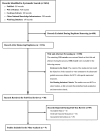Efficacy and safety of ultrasound-guided percutaneous microwave ablation for hepatocellular carcinoma at specific anatomic sites of the liver: a systematic review and meta-analysis
- PMID: 40476052
- PMCID: PMC12137246
- DOI: 10.3389/fsurg.2025.1587435
Efficacy and safety of ultrasound-guided percutaneous microwave ablation for hepatocellular carcinoma at specific anatomic sites of the liver: a systematic review and meta-analysis
Abstract
Objective: This meta-analysis aims to assess the efficacy and safety of ultrasound-guided percutaneous microwave ablation (MWA) in the treatment of hepatocellular carcinoma (HCC) located at specific anatomic sites of the liver with those of non-specific sites.
Methods: A systematic search was conducted across five databases, covering the period from the establishment of each database to September 30, 2024. Prospective and retrospective studies involving ultrasound-guided percutaneous MWA for the treatment of HCC were included. Data extraction and statistical analysis were performed using Stata 15.1 software. The main outcomes were 1-year, 3-year, and 5-year overall survival rates, complete ablation rates, and major complication rates. The results were presented as odds ratios (OR) with 95% confidence intervals (CI).
Results: A total of 9 studies were included, involving 2,381 patients, of which 1,047 had HCC at specific anatomic sites, and 1,334 had HCC at non-specific sites. The OR values (95% CI) for overall survival at 1 year, 3 years, and 5 years for patients with HCC at specific anatomic sites compared to non-specific sites were 0.89 (0.59, 1.35), 0.83 (0.66, 1.05), and 1.12 (0.91, 1.38), respectively. The OR for complete ablation rate was 0.97 (0.61, 1.53), and the OR for major complications was 1.44 (0.59, 3.51).
Conclusion: Ultrasound-guided percutaneous MWA for HCC at specific anatomic sites shows similar efficacy and safety to that at non-specific sites, with no significant differences in survival rates, complete ablation rates, or complication rates.
Keywords: liver cancer; meta-analysis; microwave ablation; specific anatomical sites; ultrasound guidance.
© 2025 Zha, Zhang, Cao, Li, Shen, Xu and Chen.
Conflict of interest statement
The authors declare that the research was conducted in the absence of any commercial or financial relationships that could be construed as a potential conflict of interest.
Figures



Similar articles
-
Efficacy and safety of ultrasound-guided percutaneous microwave ablation for hepatocellular carcinoma at specific anatomic sites of the liver: a systematic review and meta-analysis.BMC Gastroenterol. 2025 Jul 7;25(1):505. doi: 10.1186/s12876-025-04081-w. BMC Gastroenterol. 2025. PMID: 40624629 Free PMC article.
-
Comparison of microwave ablation and radiofrequency ablation for hepatocellular carcinoma: a systematic review and meta-analysis.Int J Hyperthermia. 2019;36(1):264-272. doi: 10.1080/02656736.2018.1562571. Epub 2019 Jan 24. Int J Hyperthermia. 2019. PMID: 30676100
-
Ultrasound-guided percutaneous microwave ablation for hepatocellular carcinoma originating in the caudate lobe: A pilot clinical study.J Cancer Res Ther. 2021 Jul;17(3):764-770. doi: 10.4103/jcrt.JCRT_1851_20. J Cancer Res Ther. 2021. PMID: 34269311 Clinical Trial.
-
Efficacy and Safety of Microwave Ablation (MWA) for Hepatocellular Carcinoma (HCC) in Difficult Anatomical Sites in Egyptian Patients with Liver Cirrhosis.Asian Pac J Cancer Prev. 2019 Jan 25;20(1):295-301. doi: 10.31557/APJCP.2019.20.1.295. Asian Pac J Cancer Prev. 2019. PMID: 30678453 Free PMC article.
-
Different power modes of microwave ablation for hepatocellular carcinoma: Evaluation of recurrence rate and factors related to recurrence.Asian J Surg. 2023 Sep;46(9):3520-3528. doi: 10.1016/j.asjsur.2023.03.070. Epub 2023 Mar 29. Asian J Surg. 2023. PMID: 37002048
References
-
- Vogl TJ, Basten LM, Nour-Eldin NA, Kaltenbach B, Bodelle B, Wichmann JL, et al. Evaluation of microwave ablation of liver malignancy with enabled constant spatial energy control to achieve a predictable spherical ablation zone. Int J Hyperthermia. (2018) 34:492–500. 10.1080/02656736.2017.1358408 - DOI - PubMed
-
- Laimer G, Schullian P, Jaschke N, Putzer D, Eberle G, Alzaga A, et al. Minimal ablative margin (MAM) assessment with image fusion: an independent predictor for local tumor progression in hepatocellular carcinoma after stereotactic radiofrequency ablation. Eur Radiol. (2020) 30:2463–72. 10.1007/s00330-019-06609-7 - DOI - PMC - PubMed
LinkOut - more resources
Full Text Sources

